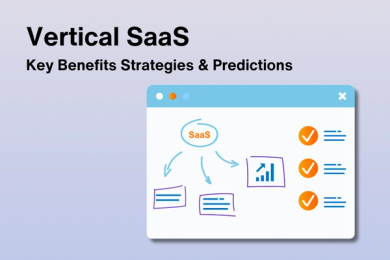Vertical SaaS: Benefits, Strategies, and Predictions
Updated May 28, 2024
Published July 22, 2023

Is your business seeking a software solution that truly understands your industry’s unique needs? Vertical SaaS provides that tailored fit.
Vertical SaaS refers to software-as-a-service solutions built specifically for niches like healthcare, finance, retail, and more. Unlike one-size-fits-all horizontal SaaS, vertical SaaS takes a specialized approach.
In this article, we explore:
- The advantages of vertical SaaS
- Strategies for success in the vertical SaaS market
- Predictions for the future of vertical SaaS
What is Vertical SaaS?
When it comes to software-as-a-service (SaaS), there are two main categories: horizontal and vertical SaaS. Horizontal SaaS provides broad solutions like email marketing, customer relationship management, and accounting that can work for businesses across different industries.
You can think of horizontal saas as one-size-fits-all services. Renowned examples of horizontal SaaS include Salesforce, a customer relationship management solution, and Mailchimp, an email marketing platform.
Vertical SaaS takes a more tailored approach. It offers software designed specifically for a niche like healthcare, insurance, or retail. These specialized solutions are customized to meet the particular needs and challenges of individual industries. They aim to provide a more focused service.
For instance, Veeva Systems is one of the well-known vertical SaaS examples. It is a vertical SaaS solution designed specifically for the life sciences industry, while Procore provides management software that caters to the construction industry.
The main difference between the two is their approach. Horizontal SaaS tries to appeal to a wide range of users. Vertical SaaS zooms in on specific industries, offering niche solutions that are often more effective for those targeted users.
Key Benefits of Vertical SaaS
Vertical SaaS provides focused value for specific industries in several ways:
Greater Personalization and Relevance
Since vertical SaaS targets a niche, it can deeply customize the platform experience to match users’ workflows and needs. This leads to greater adoption and engagement as the solution feels tailored. For example, Veeva built life sciences industry expertise into its UI, terminology, and functionality.
Lower Customer Acquisition Costs
With an in-depth understanding of a vertical, providers can fine-tune marketing and sales strategies to efficiently reach buyers. Targeted outreach and messaging cut down on wasted spend to land customers. Vertical SaaS companies see up to 22% lower customer acquisition costs and fulfill customer requirements up to 8x easier.
Stronger Customer Retention
When a solution is purpose-built for an industry’s challenges, it provides ongoing relevance that keeps customers loyal. Vertical SaaS sees lower churn rates compared to generalized platforms. A good rule of thumb for vertical saas companies is to asim for a gross churn rate of less than 10%. Sticky solutions lead to longer lifetime values and higher CLV/CAC ratios.
Smoother Integrations and Workflows
Vertical SaaS is designed to interoperate seamlessly with other niche systems like EHRs in healthcare or core banking systems in finance. This enables efficient workflows and a unified technology ecosystem for the industry.
Greater Efficiency and Productivity
Since vertical SaaS solves industry-specific pain points, it makes operations more streamlined. Companies can expect gains in productivity by switching to vertical solutions tailored to their needs. This translates into superior ROI.
Market Leadership in the Niche
Expertise in a vertical allows SaaS providers to lead that market space. They become entrenched and set the standard given their specialization. Horizontal platforms struggle to replicate capabilities built for a specific industry.
Easy, Flexible Scalability
Cloud-based vertical SaaS can scale up or down on demand without large infra investments. Usage-based pricing provides flexibility. This makes it easy to test and right-size solutions for industry niches.
By focusing on addressing the distinct needs of individual verticals, specialized SaaS delivers key business advantages.
Strategies for Vertical SaaS Success
While vertical SaaS offers significant benefits, providers also face challenges like competition, small target markets, and niche complexity. However, vertical SaaS companies can overcome these hurdles through several key strategies:
Build Strong Customer Relationships
Develop close relationships with customers to boost loyalty and reduce churn. Take time to thoroughly understand users’ specialized needs and priorities. Provide white-glove service tailored to each customer. High lifetime value and retention will follow.
Leverage In-Depth Industry Expertise
Stay on top of the latest technologies and trends impacting the niche. Use specialized knowledge to anticipate customer challenges and requirements. Expertise will help drive continuous innovation tailored to the vertical.
Offer Customizable, Flexible Solutions
Prioritize configurability and integration capabilities. Accommodate different workflows, requirements, and objectives. This flexibility provides value across the target market.
Ensure Regulatory and Compliance Expertise
Meet the complex regulatory and compliance obligations of the industry. Healthcare, financial services and other regulated verticals require security controls and stringent adherence.
Create Targeted Marketing Campaigns
Craft messaging that speaks directly to the industry’s priorities. Allocate the budget to channels and communities specific to the vertical. Sharp targeting compensates for a smaller market.
Commit to Ongoing Innovation
Rapidly adopt new technologies that solve emerging niche challenges. Continually expand platform capabilities aligned to customer needs. Innovation and specialization will drive competitive differentiation.
With this laser focus on expertise, customer centricity, and continuous evolution, vertical SaaS can overcome hurdles and deliver compelling value.
Vertical SaaS Predictions
As vertical SaaS continues to evolve, we can expect to see advances in some important technology areas that will shape the next generation of solutions.
Speeding Development with Low-Code Tools
First, new low-code and no-code platforms will help vertical SaaS companies build niche apps faster. These tools from companies like Bubble let you make software with minimal coding. This means developers can focus on high-value tasks instead of routine coding. It also opens up app creation to more non-technical people. These easy-to-use platforms will drive the growth of specialized vertical solutions across many industries. Companies can quickly roll out tailored apps even for small target groups.
Managing Rising Data Volumes
Second, as vertical SaaS gathers more industry data, companies will need to improve how they manage all that information. They’ll need strong systems to take data from different sources and combine it for analysis. This includes things like setting policies for who can access data and encrypting private information like healthcare records. Vertical SaaS companies also need to make sure their software can connect with other tools their customers use. Doing these things will help them get the most value from their data. It also keeps sensitive information secure, which builds trust.
Integrating AI for Deeper Insights
Third, integrating artificial intelligence (AI) will help vertical SaaS companies get more useful insights from their data. AI chatbots and assistants can make software interactions feel smarter and more human. AI tools can also help predict trends and outcomes. This allows companies to make better decisions. And AI can find patterns in huge amounts of industry data that humans might miss. Overall, AI gives vertical SaaS companies new ways to serve customers based on data. It makes the software more powerful yet easy to use.
Prioritizing Cybersecurity and Compliance
Fourth, vertical SaaS companies need to focus on cybersecurity and compliance, particularly in highly regulated industries like finance and healthcare. Security should be a top priority as they develop software. Companies also must follow industry rules and standards closely. Strategies like access controls, access controls, penetration testing, and security training will help avoid breaches and build customer trust.
By focusing investment in these critical technology areas, vertical SaaS providers can maintain their competitive edge and continue leading targeted innovation.
Final Thoughts
Vertical SaaS brings the potential for solutions highly tailored to niche industries. Benefits like personalization, lower costs, and tighter integrations are compelling. However, a narrow focus also poses challenges.
While the future impact remains unclear, vertical SaaS represents a wave of innovation for specialized needs. Powered by emerging technologies and industry expertise, it aims to drive efficiency through focus.
Vertical SaaS won’t replace but rather complement horizontal platforms. The potential is there to transform workflows through precision. For the right cases, specialized can mean better business.
Share This Post
Della Yang
Della Yang is a marketing professional with a passion for the ever-changing digital landscape. She frequently writes tech news and reviews, sharing her knowledge and insights through blogs and various online platforms.
Allow cookies
This website uses cookies to enhance the user experience and for essential analytics purposes. By continuing to use the site, you agree to our use of cookies.
